SCOTTSDALE, Arizona — Botulinum toxin type A (BT), commonly known as Botox, may play a role in the treatment of bipolar depression and social anxiety disorder, preliminary research suggests.
In two small case series, injecting BT into the glabellar region of the face — the area between the eyebrows and above the nose — reduced symptoms of treatment-resistant bipolar depression as well as social anxiety. To read the full article, click here.
 Dr. Eric Finzi will be a guest on NPR Boston’s The Colin McEnroe Radio Show today at approximately 1:06PM EST talking about the Botox for Depression research study findings published in the Journal of Psychiatric Research (May 2014). The study “Treatment of Depression with onabotulinumtoxinA: A Randomized Double-Blind, Placebo Controlled Trial” found that 52% of subjects suffering from moderate to severe depression showed a relief from depression after injection of botulinum toxin to the glabellar area between the eyes, compared with only 15% of those who received the saline placebo. A second phase to this study is in the works.
Dr. Eric Finzi will be a guest on NPR Boston’s The Colin McEnroe Radio Show today at approximately 1:06PM EST talking about the Botox for Depression research study findings published in the Journal of Psychiatric Research (May 2014). The study “Treatment of Depression with onabotulinumtoxinA: A Randomized Double-Blind, Placebo Controlled Trial” found that 52% of subjects suffering from moderate to severe depression showed a relief from depression after injection of botulinum toxin to the glabellar area between the eyes, compared with only 15% of those who received the saline placebo. A second phase to this study is in the works.
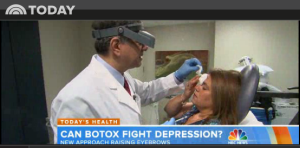
 Is botulinum toxin a viable treatment option for major depressive disorder?
Is botulinum toxin a viable treatment option for major depressive disorder? In the largest study to date on the effect of botulinum toxin on depression, researchers Eric Finzi, MD, PhD, and Norman E. Rosenthal, MD, found that 52% of subjects suffering from moderate to severe depression showed relief from depression after injection of botulinum toxin to the glabellar area between the eyes, compared with only 15% of those who received the saline placebo. The study, “Treatment of depression with onabotulinumtoxinA: A randomized, double-blind, placebo controlled trial” was published in Journal of Psychiatric Research, Volume 52 (May 2014). These findings help to confirm a novel concept for mental health – using facial expressions to influence thoughts and feelings.
In the largest study to date on the effect of botulinum toxin on depression, researchers Eric Finzi, MD, PhD, and Norman E. Rosenthal, MD, found that 52% of subjects suffering from moderate to severe depression showed relief from depression after injection of botulinum toxin to the glabellar area between the eyes, compared with only 15% of those who received the saline placebo. The study, “Treatment of depression with onabotulinumtoxinA: A randomized, double-blind, placebo controlled trial” was published in Journal of Psychiatric Research, Volume 52 (May 2014). These findings help to confirm a novel concept for mental health – using facial expressions to influence thoughts and feelings. 

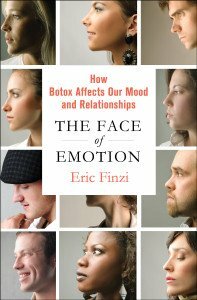
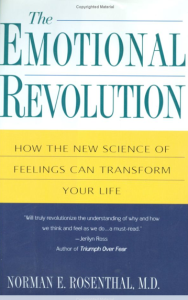 Another reason why Finzi’s idea appealed to me so much is that over a decade before he approached me, I had written a book about the science of emotion, called The Emotional Revolution. In it I wrote:
Another reason why Finzi’s idea appealed to me so much is that over a decade before he approached me, I had written a book about the science of emotion, called The Emotional Revolution. In it I wrote: It was highly plausible to me that frowning might send signals to the brain via different cranial nerves – the facial and trigeminal nerves. But in this case, it seemed, the signals aggravated a person’s mood rather than relieving it. So it made all the sense in the world to me that blocking these signals might reverse depression.
It was highly plausible to me that frowning might send signals to the brain via different cranial nerves – the facial and trigeminal nerves. But in this case, it seemed, the signals aggravated a person’s mood rather than relieving it. So it made all the sense in the world to me that blocking these signals might reverse depression.




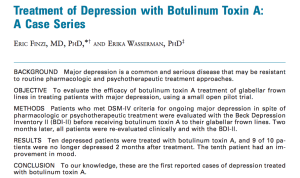 More than ten years ago I hypothesized that Botox could help control the flow of negative emotions by quieting the facial muscles that really express negativity, the muscles between the eyebrows that help create the frown. In 2003, I began a clinical trial to test my hypothesis that Botox inhibition of the frown muscle could help depressed patients. My 2006 study, Treatment of Depression with Botulinum Toxin A: A Case Study showed that nine of the ten patients were no longer clinically depressed after Botox injections into their frowns. Exciting but just the beginning! Although the press covered the study around the world few seemed to understand the science behind the experiment. Botox was an emotional molecule for many, which distracted attention from the real science behind the study. I realized that the message would need to be much clearer – so I began to write a book about the science behind my study and what led to my hypothesis– explaining why facial expressions could be used to treat depression, why frowning might send signals to the brain making one more depressed .
More than ten years ago I hypothesized that Botox could help control the flow of negative emotions by quieting the facial muscles that really express negativity, the muscles between the eyebrows that help create the frown. In 2003, I began a clinical trial to test my hypothesis that Botox inhibition of the frown muscle could help depressed patients. My 2006 study, Treatment of Depression with Botulinum Toxin A: A Case Study showed that nine of the ten patients were no longer clinically depressed after Botox injections into their frowns. Exciting but just the beginning! Although the press covered the study around the world few seemed to understand the science behind the experiment. Botox was an emotional molecule for many, which distracted attention from the real science behind the study. I realized that the message would need to be much clearer – so I began to write a book about the science behind my study and what led to my hypothesis– explaining why facial expressions could be used to treat depression, why frowning might send signals to the brain making one more depressed .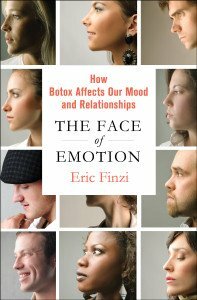 Last year I published “The Face of Emotion: How Botox Affects Moods and Relationships” (Palgrave Macmillan), providing a framework for understanding the therapeutic power of our facial expressions. In it I wrote:
Last year I published “The Face of Emotion: How Botox Affects Moods and Relationships” (Palgrave Macmillan), providing a framework for understanding the therapeutic power of our facial expressions. In it I wrote: